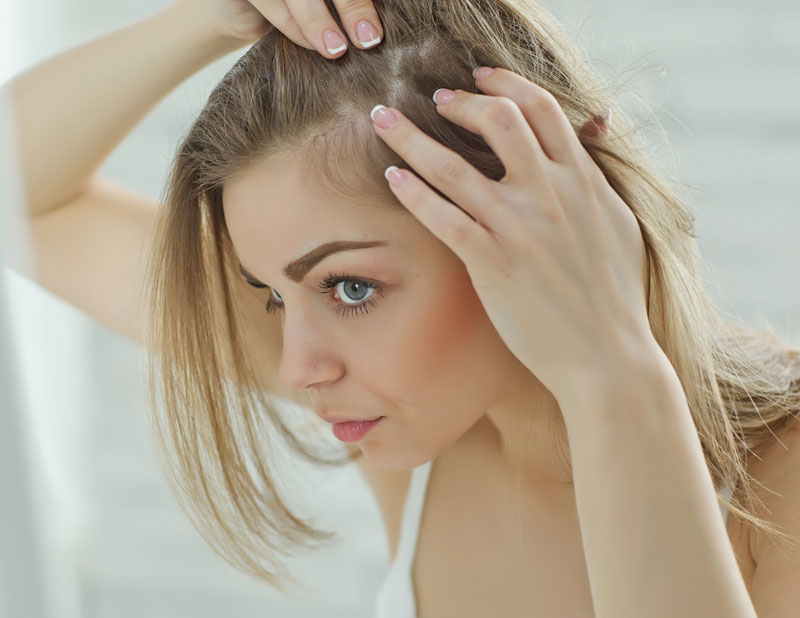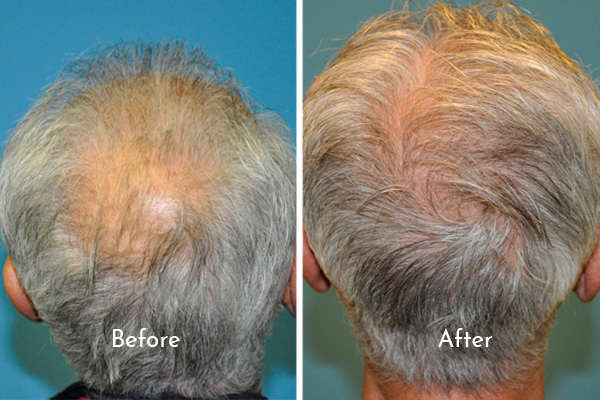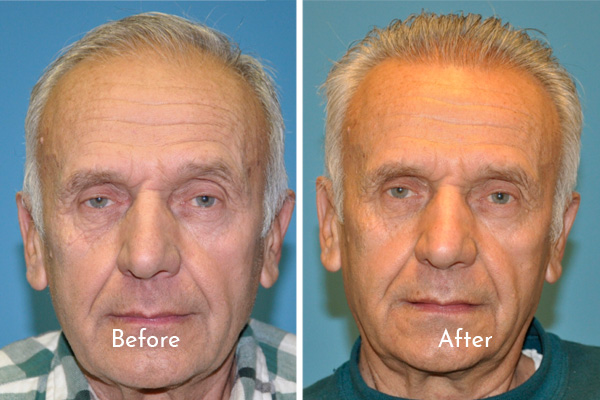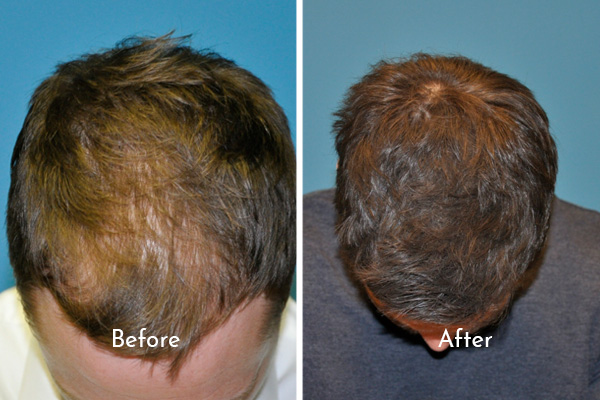Our hair is often one of our most distinguishing features. A full head of well-groomed hair is often considered not only attractive but a conveyor of youth and vigor. However, it’s common, especially in men, to see foreheads expand with age as hairlines retreat. Other baldness patterns may manifest themselves in people as young as 20, especially on the crown, or top, of the head.
Schedule a Consultation
For a consultation or to schedule an appointment, call or fill out the form. During your consultation, we will listen to your goals and spend time educating you about your treatment options and develop a customized hair transplant treatment plan.

Early Signs of Balding
While you may retain your head of hair well into your middle age, you might start noticing the early signs of balding at any time. They can include:
- Thinning around the temples
- Widening part
- Hair loss in clumps
- Loss of hair all over the body
Other Natural Signs of Aging Hair
Hair loss isn’t exclusive to men, and it isn’t the only sign of aging in relation to our scalp and what grows, or doesn’t, out of it. Other signs include:
- Loss of pigment (hair goes grey or white)
- Changes to texture
- Loss of volume
- Hair dries out or becomes more brittle
When we are young, we don’t usually pay attention to these things or concern ourselves with the first grey hair we spot, but they become ever more apparent as we age. According to heathline.com, we can see hair loss in people as young as teens, although it is more prevalent at ages 60+.

What Causes Hair Loss
Besides aging, hair loss can be caused by different factors.
- Alopecia – various forms
- Genetics
- Hormonal Changes
- Injury to Follicles
- Nutritional Deficiency
- Thyroid Imbalance
- Tinea Capitis – Fungal infection
- Telogen Effluvium – Emotional stress or stress on the body due to medication
Hair Restoration Therapy – FUE Hair Transplants from Barr Aesthetics
Hair loss has the potential to diminish overall body image satisfaction for many people- men and women alike. Knowing this, it isn’t surprising that hair restoration therapy is one of the most common cosmetic procedures performed among men in the United States. Among the most successful and most natural-looking hair restoration therapies is follicular uni extractions, also known as FUE.
Who is a Good Candidate for FUE Hair Transplants?
FUE hair transplants are good for both men and women experiencing hair loss. This treatment is recommended for people over the age of 25 since early in the balding process it can be hard to determine the natural hairline. Waiting until the balding is more prevalent allows for better planning regarding transplant placement.
At Barr Aesthetics, we also consider the following when determining who is a good candidate for FUE hair transplants:
- FUE is best for early and middle stages of hair loss, rather than advanced hair loss, since there’s less efficiency in harvesting donor follicles than there is in a follicular unit transplant (FUT) procedure, and it can be more difficult to get hair restoration coverage over a wider area.
- FUE hair transplants are especially popular with people who like to wear their hair shorter since there’s less scarring with an FUE procedure than with FUT.
If you have questions about whether or not FUE is the right procedure for you, contact Barr to set up a consultation today.
What Does It Treat?
At Barr, we commonly perform FUE transplants for patients living with androgenic alopecia. If your hair loss is the symptom of another issue, let’s discuss whether FUE is the right treatment at your consultation.
What’s the FUE Transplant Procedure Like?
Process: Because a hair transplant depends on the individual placement of the follicles, it’s a very time-intensive procedure. The overall time will depend on how much area is going to be covered, and the individual number of follicle placements. However, most patients can expect upwards of three hours for the procedure.
Although the procedure can be long, patients can relax during treatment time by watching a movie or listening to music. A local anesthetic will eliminate any pain from the procedure, while a mild sedative can serve to alleviate any anxiety or discomfort from waiting.
Results: Although newly-placed follicles may shed their shafts of hair at first, the follicles are still stably placed in the transplant area so patients can expect new hair to grow back in soon, and continue to grow as part of a normal cycle.
The appearance of your FUE transplant will greatly depend on the expertise of the person who performed the procedure. The placement of donor follicles, the angle at which hair grows, and the density and dispersal of hair growth throughout your scalp is as much art as science, so it’s important to carefully choose an experienced and recommended physician. Dr. Barr has been performing FUE transplants for patients in the Salt Lake area for years, and many patients have achieved their desired results through her personalized care.
What’s the Difference Between FUE and FUT Hair Transplants?
There are two different types of hair transplant methods, which causes some confusion for patients. FUT (Follicular Unit Transplant) procedures are older, more well-known, and usually cheaper because they’ve been around longer. The FUE process is a revolutionary modification to the FUT, and therefore it’s usually more expensive, although it is rapidly becoming more affordable.
The main difference between the two procedures is the method by which donor hairs are harvested. In a FUT, linear strips of tissue are taken from an area in the scalp with lush hair growth. Individual follicles are then harvested from this tissue. In contrast, an FUE harvests individual follicles directly from the scalp, which minimizes scarring and healing time at the donor site.
Here at Barr Aesthetics, we offer both FUE and FUT hair restoration therapy, as different procedures are more suited to different patients’ situations.

FUE Hair Transplant FAQs
Will I have scarring?
Because FUE is minimally invasive in nature, there is little to no visible scarring. The tiny, round punch sites contract as they heal, and any scarring that would be visible is concealed by the surrounding hair. Even men who wear their hair high and tight rarely experience issues with visible scarring.
How natural will my hair look?
Unlike the old days of hair plugs, which gave men’s scalps a doll-wig appearance, FUE patients have very natural-looking results. The donor follicles are placed in the transplant site in natural clusters and patterns. Many patients report that even their hairstylists don’t know that they’ve had a hair transplant.
How long will the procedure take?
Since the follicles are individually harvested and placed, this is a time-consuming procedure. Patients who are having a large area treated may split the procedure into two or more sessions. As previously mentioned, plan for at least three hours for a session.
How much recovery time do I need?
Most people can return to work and other regular activities the day following their procedure. The donor sites will heal almost completely in just a few days, being virtually undetectable.
Is FUE Hair Restoration Right for You?
The best way to determine whether or not you are a candidate for hair restoration therapy and which procedure will be the best fit for you is to meet with a board-certified cosmetic surgeon who can evaluate your specific case. During your consultation, your physician will discuss the options available and make recommendations about the best treatment for you. You will see before and after photographs of actual patients who have undergone the same procedures so that you can have some idea of what to expect from your hair restoration.
Gallery




